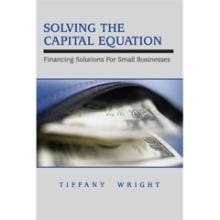By Tiffany Wright
Banks sometimes get undeserved negative reviews among small business owners. Especially in the current climate of tightening credit standards and lending policies, business owners should understand which banks lend what amounts to whom and when. Some banks will not touch a loan below $1 Million. Therefore, if you want a line of credit for $100,000, soliciting those banks will prove futile. Other banks, typically very small community banks, will not provide a loan above $1 Million. Why? Banks have loan capacities. This refers to their typical largest loan size and the maximum amount they will lend if everything lines up perfectly.
If Bank A has a general loan size limit of $3.5 Million and you need a loan for $3 Million and have plans to increase your loan amount over the next 18 months to $5 Million to pay for your business’ expansion, you should not approach Bank A for a loan. Assuming you qualify, Bank A will likely approve the $3 Million loan but not the increase meaning you will need to shop for another bank in six to nine months. Save yourself the hassle and approach the banks with general loan size limits of $6 Million and higher. Unfortunately, only a few banks explicitly state the profile of their target client or loan size. The rest is knowledge garnered only through research and relationship building -or by simply asking the appropriate bank personnel (i.e., a business banker).
Banks maintain loan portfolios. If a few of a bank’s clients in a particular industry recently defaulted on their loans, that bank will restrict its lending to other companies in that industry and sometimes, sister industries. In addition, if a bank reaches a heavy weighting in a specific business category such as residential construction and home building companies, to adjust its portfolio lending the bank will often restrict or deny all loans in that category for the remainder of the fiscal year. Thus, with a number of Georgia banks having been hard hit by the demise or financial distress of home builders due to the drastic reduction in new home sales, as a commercial construction or related company, it is worthwhile to inquire about the bank’s residential builder exposure. Many of these banks are not in a position to lend sizable amounts of money and do not publish this information but generally will acknowledge their exposure when questioned.
If you are a small business with under $10 Million in revenue, a good place to start for research is the state ranking of small business loan providers compiled by the Small Business Administration (SBA). The SBA ranks the top ten providers of SBA-guaranteed loans in each state in two categories: total volume of loans and total dollar volume. If you seek small dollar value loans (i.e., under $250,000), pursue the high loan volume group. If you seek a higher dollar value loan (i.e., $1 Million and above), pursue the high dollar volume group.
If you are pursuing a bank loan and have been turned down, ask yourself some questions.
· “Did we approach someone with signature authority or did we meet with a low level employee who has to fight for every dollar above $25,000 or $50,000 that he or she requests?
· “Did we dress professionally and project confidence or did we show up in shorts and appear surprised by all the questions asked of us?
· “Did we discuss our intention to build a long-term relationship with a bank we can grow with or did we say we were shopping around for the best rates?
· “Did we provide a loan package – an executive summary and our financial statements - or did we jot some information on a post-it note?”
If your response was the first option for each question, then conduct research on what types of banks may get you to yes and what alternative capital sources may exist. If you responded yes to the second option for each question, you must work on your packaging and preparation before you approach another bank or any other financing source. If you are not prepared, you cannot provide a modicum of a financial statement or other finance-related information, and you cannot adequately describe your business and market in words, then you will likely continually be turned down by banks and by many of the alternative financing sources.
A bank does not want to see a business plan. Instead, they want to see a very condensed, highly relevant synopsis of the business plan called the Executive Summary. This is typically three to five pages long and includes the following:
1) General overview of the business;
2) Industry overview;
3) Market overview including competitive advantage;
4) Management team including board of advisors;
5) Growth plan for the business;
6) Financing need and why;
7) A chart of sources and uses of funds.
Each section should be about one to two paragraphs each. Attached to the Executive Summary should be historical financials for the past three years, audited or reviewed. If the financials have not been audited or reviewed by a CPA – and the overwhelming majority of small business financials have not – then copies of the business tax returns for the prior three years are needed.
One last point: Build and nurture a relationship with your banker. A true banker is someone who has decision-making authority…typically someone who has signature authority for $500,000 or above. Cultivating a relationship with a good banker is well worth the effort. That banker will support you when your margins drop (if kept informed), point you to other financing sources if he or she cannot directly assist, and seek creative solutions if your loan needs exceed the limits for the bank.
Friday, August 29, 2008
Subscribe to:
Posts (Atom)





